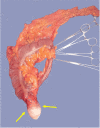Lower Gastrointestinal Bleeding Secondary to Appendiceal Mucinous Neoplasm: A Report of Two Cases and a Review of the Literature
- PMID: 38406052
- PMCID: PMC10893774
- DOI: 10.7759/cureus.52908
Lower Gastrointestinal Bleeding Secondary to Appendiceal Mucinous Neoplasm: A Report of Two Cases and a Review of the Literature
Abstract
Appendicular mucinous neoplasms, constituting less than 1% of gastrointestinal tract neoplasms, are heterogeneous entities. They may be asymptomatic, discovered incidentally, or present as large tumors due to mucin accumulation. The lack of standardized treatment complicates management. Imaging studies, particularly CT scans, are crucial for diagnosis and follow-up. This case report presents two clinical cases of women in their sixth and seventh decades of life with a history of lower gastrointestinal bleeding, mild anemia in laboratory studies, and incomplete colonoscopies. The diagnosis, confirmed through CT scans, led to the decision for surgical intervention in both cases, involving laparoscopic right hemicolectomy with ileotransverse anastomosis. Subsequently, histopathological reports confirmed the diagnosis of high-grade appendicular mucinous neoplasms, and a follow-up plan was established with imaging studies every six months with no recurrence at two years. Over 50% of appendicular tumors are mucinous neoplasms originating from low-grade mucinous neoplasms. Given the low lymph node invasion (2%), appendectomy may suffice if the entire tumor is excised. Extensive resections or right hemicolectomy are reserved for larger tumors or high-grade neoplasms to minimize local recurrence risk. Mucinous neoplasms with acellular mucin and peritoneal invasion may require cytoreduction or right hemicolectomy, while those with mucinous epithelium may need hyperthermic intraperitoneal chemotherapy (HIPEC) due to the risk of local recurrence, worsened by the presence of extra appendiceal epithelial cells. Disease-free and overall survival depend on treatment and initial lesion characterization. A five-year survival rate of 86% is reported for low-grade mucinous neoplasms. Follow-up approaches lack an ideal standard, generally involving physical examinations and imaging studies every six months to one year during the first six years.
Keywords: appendectomy; appendicular mucinous neoplasms; lower gastrointestinal bleeding; pseudomyxoma peritonei; right hemicolectomy.
Copyright © 2024, Soto Llanes et al.
Conflict of interest statement
The authors have declared that no competing interests exist.
Figures




References
-
- Appendiceal mucinous neoplasm. Khor Ee IH, Chor Lip HT, Muniandy J. ANZ J Surg. 2022;92:595–597. - PubMed
-
- Appendiceal cancer: a review of the literature. Van de Moortele M, De Hertogh G, Sagaert X, Van Cutsem E. https://pubmed.ncbi.nlm.nih.gov/33094592/ Acta Gastroenterol Belg. 2020;83:441–448. - PubMed
-
- Staging of appendiceal mucinous neoplasms: challenges and recent updates. Umetsu SE, Kakar S. Hum Pathol. 2023;132:65–76. - PubMed
-
- Low-grade appendiceal mucinous neoplasm. Dong J, Tian Y. Clin Res Hepatol Gastroenterol. 2021;45:101647. - PubMed
Publication types
LinkOut - more resources
Full Text Sources
